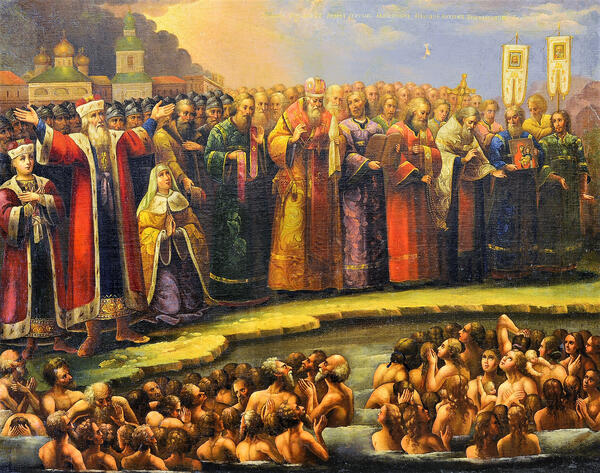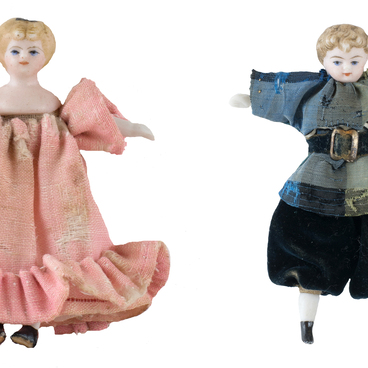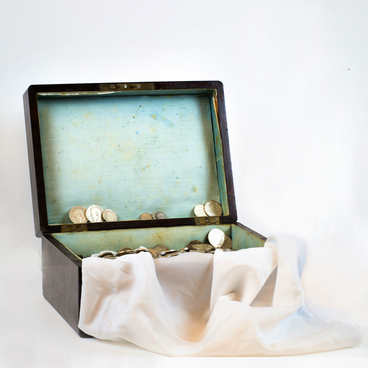The Murom painter Ivan Patyrmin painted icons and pictures of religious content. Among his works was a canvas on the church-historical theme “Baptism of the Murom People by the Saint Prince Constantine.” It is displayed at the exposition of the museum.
Usually, Patyrmin used engravings of the German Romantic artist Julius Karolsfeld to create other paintings. However, in this work he focused on the artistic examples presented in his hometown. The master took his inspiration from the icon “Lives of Saint Princes Constantine, Mikhail and Feodor, ” which was collectively painted by the Murom icon painter Alexander Kazantsev and his son Peter in 1714. On its border scenes — small rectangular images on the sides — the master placed plots of an important historical event for the Murom church: the baptism of local pagans. Like the painting by Patyrmin, this icon is a part of the museum’s collection. Previously, the icon paintings of saint princes were on the porch eastern wall of the Cathedral of the Annunciation of the Monastery.
Among 87 scenes Patyrmin chose those in which Kazantsev depicted baptism scenes in the Oka River, there were 43 — 46 border scenes. The painter did not use them directly, but artistically redesigned them.
The painting blends the canonical icon painting techniques and the principles used in painting and engraving by Western European artists. For example, the static crowd of people and soldiers on the bank of the Oka River was shown by Patyrmin as “innumerable amount”. People stand one after another, the crowd reaches the background of the picture, the distant faces and heads are depicted sketchily by the master. In the foreground, there are those converting to Christianity in the river. Potyrmin showed them in dynamic poses, and the movement of the river conveyed through the contrasts of light and shadow.
He carefully painted the architectural structures, as well as the clothes of the princely family and the priests. However, the ornaments and details of the vestments of the other clergymen correspond not to a depicted period of time, but to the last third of the 19th century, i.e. the time when the painting was created. The same period represents the religious banners on the canvas by Patyrmin, as well as the icon of Our Lady of Murom. Instead of a deserted shore and a wooded hill, as they were in ancient times, the master painted a stone temple and buildings around — a supposed Murom.
Patyrmin’s work, aside from the influence of Kazantsev’s 1714 icon, has a resemblance to another of his icons, “The Synaxis of All Saints of Murom.”
Usually, Patyrmin used engravings of the German Romantic artist Julius Karolsfeld to create other paintings. However, in this work he focused on the artistic examples presented in his hometown. The master took his inspiration from the icon “Lives of Saint Princes Constantine, Mikhail and Feodor, ” which was collectively painted by the Murom icon painter Alexander Kazantsev and his son Peter in 1714. On its border scenes — small rectangular images on the sides — the master placed plots of an important historical event for the Murom church: the baptism of local pagans. Like the painting by Patyrmin, this icon is a part of the museum’s collection. Previously, the icon paintings of saint princes were on the porch eastern wall of the Cathedral of the Annunciation of the Monastery.
Among 87 scenes Patyrmin chose those in which Kazantsev depicted baptism scenes in the Oka River, there were 43 — 46 border scenes. The painter did not use them directly, but artistically redesigned them.
The painting blends the canonical icon painting techniques and the principles used in painting and engraving by Western European artists. For example, the static crowd of people and soldiers on the bank of the Oka River was shown by Patyrmin as “innumerable amount”. People stand one after another, the crowd reaches the background of the picture, the distant faces and heads are depicted sketchily by the master. In the foreground, there are those converting to Christianity in the river. Potyrmin showed them in dynamic poses, and the movement of the river conveyed through the contrasts of light and shadow.
He carefully painted the architectural structures, as well as the clothes of the princely family and the priests. However, the ornaments and details of the vestments of the other clergymen correspond not to a depicted period of time, but to the last third of the 19th century, i.e. the time when the painting was created. The same period represents the religious banners on the canvas by Patyrmin, as well as the icon of Our Lady of Murom. Instead of a deserted shore and a wooded hill, as they were in ancient times, the master painted a stone temple and buildings around — a supposed Murom.
Patyrmin’s work, aside from the influence of Kazantsev’s 1714 icon, has a resemblance to another of his icons, “The Synaxis of All Saints of Murom.”



